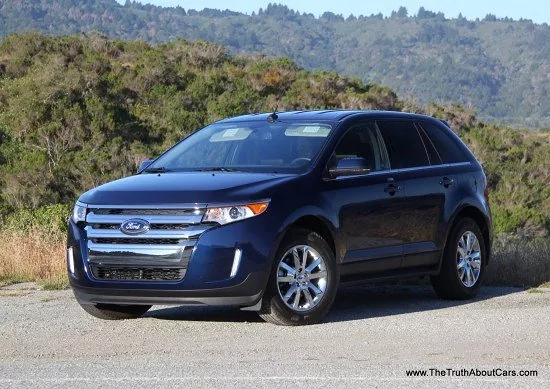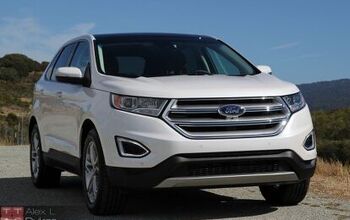Review: 2012 Ford Edge Limited EcoBoost

Once upon a time, in a country known as America, SUVs roamed the land with large-displacement inline 6s, optional V8s, and locking axles. Nobody had heard of a “cute ute.” Of course, gasoline was also under a buck a gallon. Today the landscape is different. While the last energy crisis caused entire vehicles to downsize, the response to the latest energy “crisis” (and government pressure) has been to downsize engines while leaving the rest of the vehicle intact. Case in point? The Ford Edge EcoBoost. No, this isn’t the 3.5L fire-breathing twin-turbo you’ve heard about before, this is the all-new 2.0L engine that puts the Eco in EcoBoost.
Exterior
In 2007 Ford sold over 130,000 Edge CUVs, but sales slid slowly as the financial meltdown and high gasoline costs put shopper on notice. In order to keep things fresh, Ford face-lifted the Edge for 2011. While the proportions remain the same—a wide stance, slab sides, stubby schnozz and a raked windshield—Ford seems to have ditched their attempt at styling the Edge to look smaller. To that end, the formerly demure three-bar “Gillette” grill has been replaced with an Audi-esque billy-the-big-mouth-bass affair covered in all the chrome bling you could wish for. While some were offended by the large expanses of chrome-effect plastic, I think a bold front end is exactly what Ford needs to differentiate the Edge from the plethora of me-too CUVs on the road. That being said, the Jeep Grand Cherokee is still more visually exciting.
Interior
Our Edge tester was a “Limited” trim model. Starting at $34,940 and bringing standard goodies like dual-zone climate control, leather, 10-way power seats, an up-level Sony audio system and Ford’s MyFord Touch infotainment system, the Limited sits at the top of the Edge food chain. If these goodies don’t piqué your interest, the Edge SEL crosses the infotainment upgrades off the equipment list for $31,400 and the base Edge SE EcoBoost starts at $28,845 with cloth seats and manual HVAC knobs. Regardless of trim level, the Edge’s parts quality and fit-and-finish are easily the best in its class. Even the Limited’s faux-wood trim is plausible in terms of realistic texture and tasteful distribution. The Edge seems to represent Ford’s continuing march toward premium interiors at premium price points. While this is no doubt a good direction for the brand, if you’re looking for a cheap, rough-and-tumble CUV replacement for your old Bronco II, this isn’t it. Strangely, the only real problem I have with the Edge’s interior is that it’s nice enough that I see little reason (aside from some real-wood) to upgrade to the Lincoln MKX. Thanks to the generous, corn-fed proportions, the cargo capacity of the Edge is a large 32 cubic feet expanding to 69 cubic feet with the rear seats folded.
Infotainment
Like the Android vs iPhone debate, infotainment systems spark fierce controversy. No system since iDrive has received as much bad press mixed with forum fan-boy rave reviews as MyFord Touch. Let’s cut to the chase. The 2012 Edge benefits from major software update designed to make the system more responsive and easier to use. During a previous week with the 2011 system, we experienced frequent freezing, random crashes, periodic reboots and the ever-so-popular “blue screen of death.” The 2012 version performed reliably. That’s not to say MyFord Touch is now perfect. The system is still dreadfully slow when compared to iDrive, UConnect 8.4 and Cadillac’s new CUE system. If slow interfaces bother you, just buy an Edge SEL, select every option except the Ford MyTouch system and you’ll essentially have a Limited without MyFord Touch. By doing so you can still get the backup camera and the voice activated SYNC system which work flawlessly. The downside? You won’t get the snazzy 4.2-inch LCDs on either side of the speedometer. Despite the sloth, my opinion is that MyFord Touch is one of the best systems on the market (after iDrive) in terms of functionality, aesthetics and ease of use. Yes the system is painfully slow at times, but I’d rather have a sluggish system that did everything MyFord Touch does than a snappy system that only covered the basics.
Drivetrain
Ah, the section you’ve all be waiting for. Aside from the revised MyFord Touch system, the reason we’re looking at the Edge is the new EcoBoost engine. No, this isn’t the fire-breathing 3.5L twin-turbo monster that Ford is jamming under as many hoods as possible, this is the engine that puts the “eco” in EcoBoost. Ford started out with a 2.0L four cylinder aluminum block, added twin cams with independent variable valve timing, bolted on a Borg Warner (KKK) K03 turbocharger and lathered on the direct-injection sauce. The K03 is good for 16psi of boost which yields 240HP, 270lb-ft of torque and a “claimed” 30MPG on the highway.The observant in the crowd will note that while this is a 45HP decrease from the 3.5L V6, there is an extra 17lb-ft of torque-on tap. Speaking of torque, all 270lb-ft come to the boil at 1750RPM and stay strong to 4,500RPM while the 3.5L V6 peaks at 4,000. As long as the turbos are spooled up, the engine produces more torque at a given RPM than the V6. It’s this broad torque curve that allows the EcooBoost Edge to scoot to 60 only 0.4 seconds slower than the 3.5L V6 despite the drop in HP and the slight delay in off-the-line acceleration. The cost for this gem? $995. Power is sent to the front wheels via Ford’s 6-speed automatic transmission. Why there is no AWD option for this engine is anyone’s guess. The EcoBoost engine idles as smoothly as BMW’s 2.0L DI turbo – in other words, it sounds like a quiet diesel engine.
Drive
Thanks to extensive sound insulation, the only way you would know the 2.0L turbo lurks under the hood is by the way the Edge drives and gulps gasoline. Unlike the fuel-efficient engine choices of the last century, I prefer the way the 2.0L turbo drives to V6. Why? It’s all in the way the power is delivered. With all that twist arriving at low RPMs, the fact that the transmission is programmed to be recalcitrant to shift (for fuel economy) is not only a non-issue, it makes maintaining speed on a mountain grade a smoother affair than the V6 Edge which constantly hunts for the right gear. As you would expect with 270lb-ft on tap, torque steer and one-wheel burnouts are a mere throttle stab away. If I hadn’t driven an EcoBoost and V6 Edge back-t0-back I would have thought the turbo was the faster vehicle to 60 which arrived in just under 7.6 seconds.
The suspension in the Edge is tuned toward the softer side of CUVs, delivering a ride that is compliant and composed over all the broken pavement we could throw at it. This is thanks to the tall 60-series tires standard on the Edge as well as the wide 65-inch track. While I wouldn’t ever call a two-ton crossover a “corner carver,” the Edge is in many ways a grossly overweight Mazda 6 and handles as such. Remind you of a CX-7? It should. On windy mountain roads it can pull up its support hose and feign some dance moves, but it is unlikely the average buyer will ever try.
If you’re shopping for a two wheel drive crossover and need the generous capacity the Edge offers, the EcoBoost model is hand-down Ford’s best offering. If however you’re looking for fuel efficiency in a 5-seat crossover the Edge EcoBoost becomes a less exciting proposition. During our 734-mile week with the Edge we averaged 24.2MPG with conservative driving and plenty of highway miles. While this does represent a nearly 5MPG improvement over the 3.5L V6 Edge on the same driving cycle and a break-even point of around 4 years for the $995 engine option, city dwellers and those with lead feet will find themselves averaging 19-20MPG. Despite the active shutters and a cool, A/C-free coastal California drive, the Edge struggled to average 29MPG with the cruise control set to 65MPH. Despite not living up to its EPA numbers, the EcoBoost delivered a superior driving experience and a true 20-25% improvement in fuel economy meaning. There is just one problem: the all-new Ford Escape. Despite being rated a very similar 22/30MPG, our short stint with the 2.0L EcoBoost Escape proves that its real world average is around 27MPG. While the Escape is smaller than the Edge, it’s also more nimble, handles better, lighter, faster, cheaper and AWD is an option.
Not a fan of our Facebook page? Too bad, if you liked us on Facebook you’d know what we have on the front burner. Get on, get social and tell us what you want to see.
Ford provided the vehicle, one tank of gas, and insurance for this review
Specifications as tested
0-30: 2.73 Seconds
0-60: 7.59 Seconds
1/4 Mile: 15.95 Seconds @ 84.7 MPH
Average Fuel Economy: 24.2 MPG over 734 miles

More by Alex L. Dykes
Latest Car Reviews
Read moreLatest Product Reviews
Read moreRecent Comments
- ToolGuy TG likes price reductions.
- ToolGuy I could go for a Mustang with a Subaru powertrain. (Maybe some additional ground clearance.)
- ToolGuy Does Tim Healey care about TTAC? 😉
- ToolGuy I am slashing my food budget by 1%.
- ToolGuy TG grows skeptical about his government protecting him from bad decisions.

































































Comments
Join the conversation
Local Dealer (best price, no negotiating) has 11 Edge Limited's available with the 2.0L turbo. Here's their pricing - which includes rebates and their discount. Lowest Priced Limited: MSRP $37,240 Discount $4,459 Best Price $32,781 Most loaded: MSRP $41,635 Discount $5,086 Best Price $36,549
Aw hell, forget these "cute utes" bring back the Olds Vista Cruiser!!